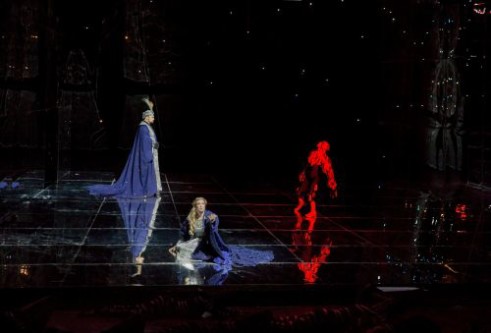R. Strauss, Die Frau ohne Schatten: Soloists, Metropolitan Opera Orchestra, Vladamir Jurowski (conductor), Metropolitan Opera House, Lincoln Center, New York, 12.11.2013 (SSM)

Cast:
The Nurse: lldiko Komlósi
The Messenger of Keikobad: Richard Paul Fink
The Emperor: Torsten Kerl
The Empress: Anne Schwanewilms
The Falcon: Jennifer Check
The Hunchback: Allan Glassman
The One-Eyed: Daniel Sutin
The One-Armed: Nathan Stark
The Dyer’s Wife: Christine Goerke
Barak, the Dyer: Johan Renter
Servants: Haeran Hong, Disella Làrusdóttir, Edyta Kulczak
Production:
Set, costume, & lighting designer: Herbert Wernicke
Stage Director: J. Knighten Smit
What are we to make of this opera and its strange albeit beautiful world? It opens in medias res with the Nurse and the Messenger discussing the fact that this is the twelfth time in the past year that he has come bearing a demand to the Empress from her father, the mysterious spirit who controls this world, that she return to him. The Messenger then tells the Nurse that this time the Empress, who is half-human and half-gazelle and has no shadow, must obtain a shadow from the human world within three days or she will have to return to her father; her husband, the Emperor, will be turned into stone. Does this make any sense? No. What it does do is provide the librettist, Hugo von Hofmannsthal, with material for a fairytale, and the composer, Richard Strauss, the inspiration for some of his most gorgeous music. Long sweeping musical lines roll in, and languorous moments such as the Third Act’s “Vater, bist du’s,” a precursor to the heart-rending “Beim Schlafengehen” from his Four Last Songs, make this one of Strauss’s greatest operas.
Strauss had composed some strange operas before this including Ariadne auf Naxos, Salomé and Elektra, but nothing as phantasmagoric as Die Frau ohne Schatten. The opera and its story are not based on familiar myths or Biblical characters as in his previous operas, and the audience at its 1919 premiere found it incomprehensible. The staging required tremendous resources from singers, designers and orchestras, and it took another half century for Die Frau to enter the repertory of contemporary opera houses. Few could put on the kind of magic show that the Met produced here.
This production is a revival of one from 2001, and it has lost none of its opulence. The two sets are built on the theater’s stage-raising elevator: the opera begins in the fantasy world which rises to reveal the all-too-human, slovenly Dyer’s house where the refrigerator is filled with beer cans and the wife fries fish in a space near the dye vats. The husband, Barak (the only named character in the opera), spends his time playing rough-house games with his brothers. His wife is a self-centered termagant. Between the human and the spirit worlds is a staircase where the characters can climb back and forth.
The staging of the other-world space was stunning, with mirrored floor, walls and ceiling. There were several scenes that particularly impressed me. The Emperor’s red falcon, who originally lead him to the Empress, returns a number of times and somersaults around the mirrored walls, at times seemingly a blur of red. Jennifer Check deserved the round of applause she received for her acrobatics. Another spectacular scene was in Act III when the spell on the Emperor is broken, freeing him from a stone encasement. For this he wore a cape made of mirrors that caught and reflected the light and was reminiscent of the Commandatore scenes in Mozart’s Don Giovanni.
Within its own logic the opera stands up well, but ultimately it becomes moralistic, preaching “go and be fruitful” philosophies supported by voices of the unborn, and simplistic clichés such as it is better to be a human than a god.
There were a few miscues, a sour turn here and there, but mostly brilliant singing.
Anne Schwanewilms, who played the same part in the very different Christof Loy production, fit the role of the Empress well and was quite impressive in her final rejection of the shadow. Although the original libretto lists the Empress as the leading female vocalist and the Dyer’s wife several singers below her, applause for Christine Goerke’s knock-out singing over shadowed that for all the other roles.
The orchestra under the direction of Vladimir Jurowski was so brilliant that I found myself focusing on the instruments. Strauss’s use of the brass section rivals Mahler’s, and the Metropolitan’s brass are nonpareil.
This was a magical production with every one of its two-hundred-and-twenty-or-so minutes riveting in every way.
Stan Metzger